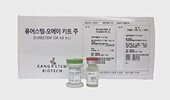KangStem Biotech is South Korean based biopharmy company/lab who is entering hair cloning market with their human hair follicle/skin organoids.
Their newest press release:
[Prime Economy] On the 21st, Kangstem Biotech (217730) signed a contract with the Seoul National University Industrial Cooperation Foundation for ‘human hair drug screening and human hair follicle production and culture technology for hair transplant materials’ to develop and commercialize hair loss treatment based on hair follicle organoids. revealed.
Kangstem Biotech plans to begin commercializing hair follicle evaluation methods and transplant treatments through the introduction of this technology. This technology is the world's first artificial production of human hair follicle organoids in a test tube, and is a technology that reproduces human hair follicles.
In addition, the goal is to develop a transplant-based hair loss treatment that replaces the existing transplantation method that involves harvesting and planting a patient's individual hair. When hair follicle organoids are transplanted into hair loss areas, side effects due to inflammatory reactions such as infection are minimized, there is no limit to the number of hair follicles required for transplantation, and convenience for patients and doctors is expected to increase through a simple transplantation procedure that omits the collection process. .
This technology allows visual evaluation of the length and thickness of hair follicles, and can simplify testing and increase accuracy compared to tissue staining methods, complementing the limitations of previous evaluation models. The company plans to apply this immediately and launch a hair follicle-based efficacy evaluation method business within the first half of next year. The project will be carried out in cooperation with leading domestic skin and human application testing institutes.
The company said, "The existing skin organoid technology was more specialized in the development of testing methods and treatments related to skin regeneration, so there was a limitation in that it was difficult to supply hair follicles of a certain quantity and quality. Therefore, in order to quickly commercialize hair follicle evaluation methods and transplant treatments, this technology focused only on hair follicles. “We have introduced technology,” he said.
He continued, “Through this contract, we have laid the foundation for entering the domestic and global hair loss treatment market. Based on this, we plan to launch a hair follicle-based efficacy evaluation project next year and begin non-clinical efficacy evaluation of transplant-based hair loss treatment products.” “We will work hard to realize sales within the first half of the year along with rapid commercialization.”
More: https://www.newsprime.co.kr/news/article/?no=622692
Website press release: https://kangstem.com/pr/ir_news/view?lang=en&i=619
Their newest press release:
[Prime Economy] On the 21st, Kangstem Biotech (217730) signed a contract with the Seoul National University Industrial Cooperation Foundation for ‘human hair drug screening and human hair follicle production and culture technology for hair transplant materials’ to develop and commercialize hair loss treatment based on hair follicle organoids. revealed.
Kangstem Biotech plans to begin commercializing hair follicle evaluation methods and transplant treatments through the introduction of this technology. This technology is the world's first artificial production of human hair follicle organoids in a test tube, and is a technology that reproduces human hair follicles.
In addition, the goal is to develop a transplant-based hair loss treatment that replaces the existing transplantation method that involves harvesting and planting a patient's individual hair. When hair follicle organoids are transplanted into hair loss areas, side effects due to inflammatory reactions such as infection are minimized, there is no limit to the number of hair follicles required for transplantation, and convenience for patients and doctors is expected to increase through a simple transplantation procedure that omits the collection process. .
This technology allows visual evaluation of the length and thickness of hair follicles, and can simplify testing and increase accuracy compared to tissue staining methods, complementing the limitations of previous evaluation models. The company plans to apply this immediately and launch a hair follicle-based efficacy evaluation method business within the first half of next year. The project will be carried out in cooperation with leading domestic skin and human application testing institutes.
The company said, "The existing skin organoid technology was more specialized in the development of testing methods and treatments related to skin regeneration, so there was a limitation in that it was difficult to supply hair follicles of a certain quantity and quality. Therefore, in order to quickly commercialize hair follicle evaluation methods and transplant treatments, this technology focused only on hair follicles. “We have introduced technology,” he said.
He continued, “Through this contract, we have laid the foundation for entering the domestic and global hair loss treatment market. Based on this, we plan to launch a hair follicle-based efficacy evaluation project next year and begin non-clinical efficacy evaluation of transplant-based hair loss treatment products.” “We will work hard to realize sales within the first half of the year along with rapid commercialization.”
More: https://www.newsprime.co.kr/news/article/?no=622692
Website press release: https://kangstem.com/pr/ir_news/view?lang=en&i=619

